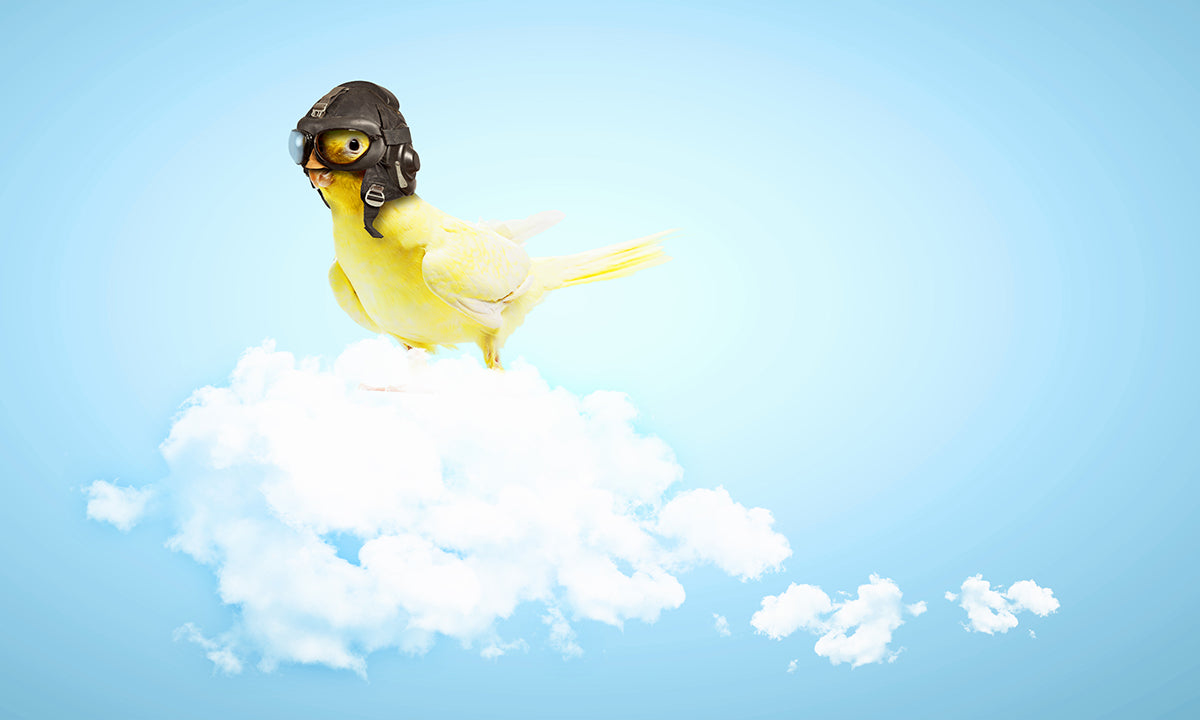
Can I bring a bird on a plane?
Airports are becoming increasingly more pet-friendly. In fact, it's not uncommon to see a crated dog or cat across the cabin aisle on any given trip. But what about birds? If you're a bird parent, you may wonder, Is my bird allowed to travel with me on a plane?

The short answer to whether your feathered friend can fly with you is yes. However, you need to know the restrictions, requirements, and rules before booking your next flight with your winged traveling companion. Only a handful of airlines allow for the transportation of pet birds. Luckily, top-rated and recognizable airline carriers are included in that shortlist, so that's a perk. Depending on the airline, pet birds can travel in-cabin, as checked baggage, or in the cargo hold. If you're considering traveling with your bird, consider the following;
- Bird and Carrier Size Matters. Generally, most rules state that birds and their carriers must be small enough to fit under the seat to ride in the main cabin. Larger birds, or birds that require a larger carrier, must ride in the cargo hold.
- Pet Birds Only. Birds must be considered "household birds" or domesticated birds. These birds include parrots, cockatoos, finches, budgies, lovebirds, canaries and cockatiels, to name a few. (Chickens and other poultry-type birds are not allowed. Sadly, Mr. Clucks will have to stay home.)
- Birds Must Be Considerate. Most, if not all, airlines state that birds must be quiet and odorless. So, if your bird is "a talker" or tends to smell a little...gamey, the cargo hold might be your best option.
- Pack Necessary Bird Health Records. Depending on the travel, destination and flight length, health releases and other forms are often required for your bird to fly on a plane. For example, travel from one state to another requires a health certificate from your avian veterinarian. On the other hand, international travel may have additional regulations to consider.
- Seasons Matter. Most airlines have rules regarding the "ground temperature" during travel for any bird transported in the cargo hold. For example, many airlines restrict pet travel if the ground temperature is above 85°F or below 45°F. Depending on where you're traveling, spring and fall may be the best time for travel to avoid extreme temperatures.
- Booking Options. Some airlines suggest booking a direct, counter-to-counter flight for cargo hold transportation. A counter-to-counter option is often a more expensive alternative where "cargo" can be dropped off and picked up at the ticket counter.
- Choose Traveling Days Wisely. Consider the time of year you're traveling. Remember, holidays and weekends tend to have more crowds and delays. Keeping your bird stress-free is key to maintaining a happy and healthy bird.
A good rule of thumb is to call the airline before purchasing your tickets so that you are aware of the latest rules and regulations regarding bird travel.
Traveling with a Bird
Once you've researched and selected the best airline for you and your feathered friend, it's time to create your traveling checklist.
Birds Traveling in the Main Cabin
- When making your reservation, a window seat may be your best option to avoid aisle noises and sudden movements that may unsettle your bird.
- Ensure you have a list of all required documentation. (You need to call your airline directly to ensure you meet all requirements.)
- Contact your avian veterinarian to verify your bird is healthy before travel and is up-to-date on all necessary vaccinations. You may also want to ask about any vitamins or supplements that may help to keep your bird happy, healthy and calm before and during travel. When traveling to and from your bird's veterinarian appointments, consider transporting your bird in the K&H Mod Bird Carrier Travel Cage. This carrier easily and safely transports birds of all sizes, buckles into your car's safety belt and is surrounded by a breathable mesh, giving your bird access to constant airflow.
- Be prepared to have your bird's carrier inspected by TSA before your flight. X-ray scans are powerful and can harm a small bird, so airlines usually opt to inspect cages instead.
- Clearly label your bird carrier in case you are separated from your bird for any reason. Be sure to include your contact information (including cell phone number), bird's name and flight information.
- Supply your bird with food. Fresh fruit is an excellent travel companion because it will help keep your bird hydrated.
- Cover your bird's carrier with a lightweight, breathable fabric to keep your bird calm.
Birds Traveling in the Cargo Hold
- In addition to clearly labeling your bird's carrier with all essential contact information, print out "LIVE ANIMAL" prominently on your bird's carrier (this also indicates the upright position of your birdcage).
- Select a safe perch placement while considering the possibility of unforeseen turbulence that could tip your bird's carrier. And make sure your bird's head and tail feathers aren't touching the cage's top and bottom.
- Provide food on the bottom of the carrier during transportation when possible. Add fresh fruit to keep your bird hydrated throughout the trip (in case water is prohibited during transport or, if allowed, is spilled for any reason). In case of separation or other unforeseen incidents, provide your bird with a two-day food supply.
Selecting a Bird Carrier
Because airlines differ in rules and regulations regarding main cabin and cargo hold containers, do a little research to ensure you purchase an "airline-compliant" pet carrier. Remember that every plane and carrier differs in size, so research your plane's seating dimensions before your trip.
Preparing Your Bird for Travel
Birds love routine, so preparing your bird before travel is essential to any successful trip. If possible, familiarize your bird with her travel carrier a week or two prior to leaving. Try to coax your bird into her carrier by offering perks such as treats or toys — this will make new surroundings less scary. You may even consider introducing airline noises by playing take-off and landing sounds via your phone or computer.
The night before, try de-stressing your bird by offering some extra pampering. The K&H Snuggle Up Bird Warmer and the K&H Thermo-Perch Heated Bird Perch are excellent items promoting relaxation for almost any bird. Both products heat safely to your bird's body temperature, aid in reducing avian stress, and attach easily to any wire cage. They also offer soothing heat that helps encourage a good night's sleep and a de-stressing experience.
Make Traveling with Your Pet Bird Easier
Preparation and research are your best allies when flying the friendly skies with your bird. Research on the front end of your trip is crucial to making the best decisions for you and your feathered friend, so be sure to call your airline before purchasing tickets and get all the tough questions answered.
Remember, your bird is more than a pet — he's family! Making sure your bird's needs are met during travel is your ultimate goal, so be diligent in pre-planning so that you and your feathered friend enjoy a little rest and relaxation on your next vacation.



Leave a comment